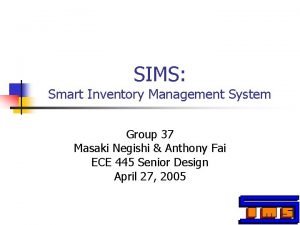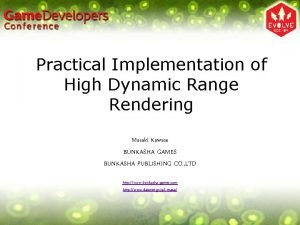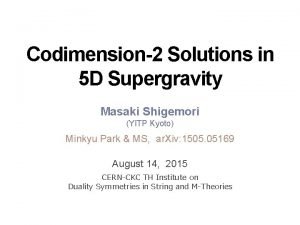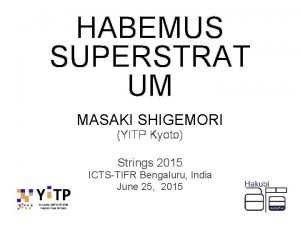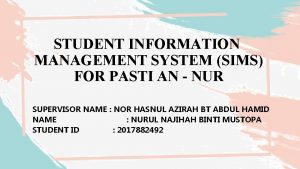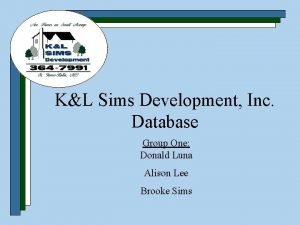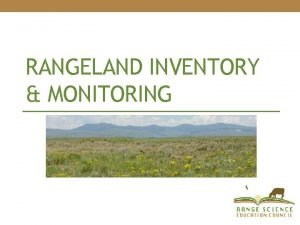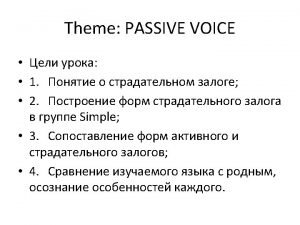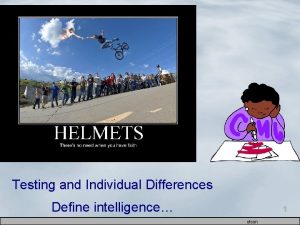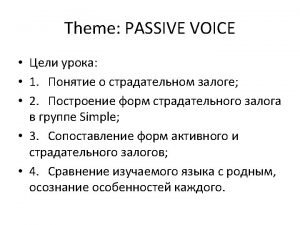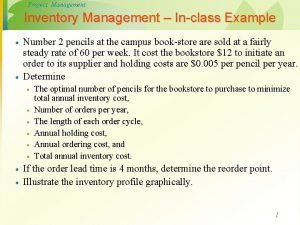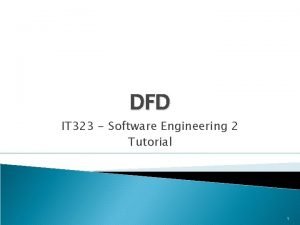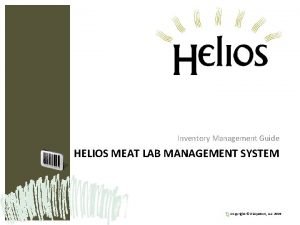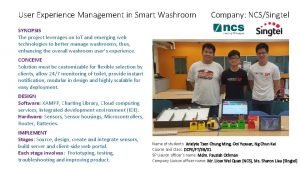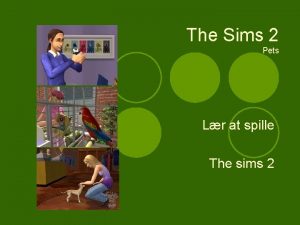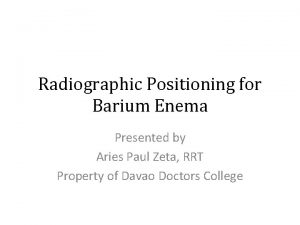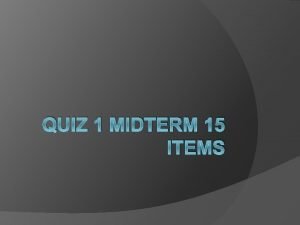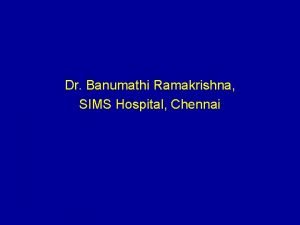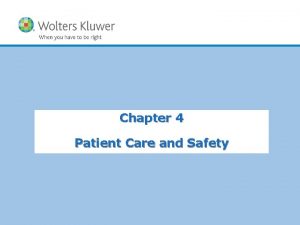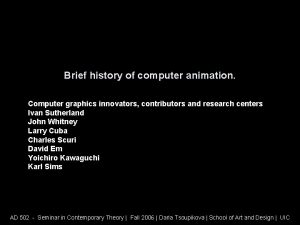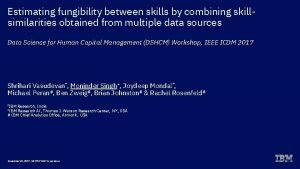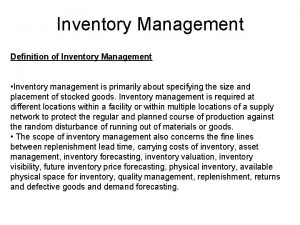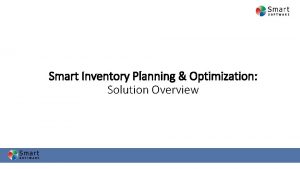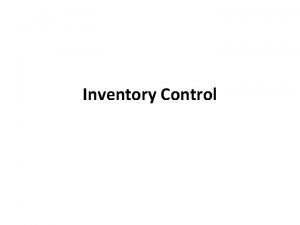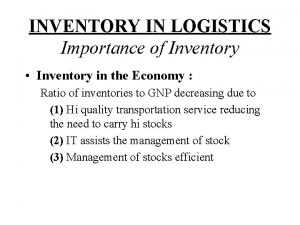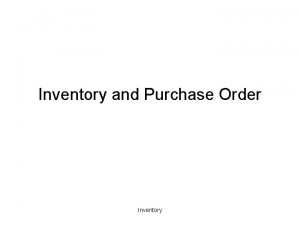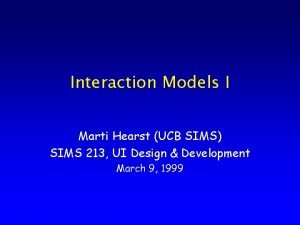SIMS Smart Inventory Management System Group 37 Masaki








































- Slides: 40

SIMS: Smart Inventory Management System Group 37 Masaki Negishi & Anthony Fai ECE 445 Senior Design April 27, 2005

Introduction n n SIMS provides a cost effective solution for the management of inventory which leverages RFID technology. Combines an antenna array to a single RFID reader to map out an area for inventory detection

Features n n PC serial interface Compatible with RFID Readers and Antennas Up to 8 outputs per unit Expandable, modular design

The images in this presentation have been reduced to screen quality (saves space) Format Picture -> Compress The SIMS System

System Overview n Hardware: n n n Power Supply, PC Interface Processing Unit, RF Switching Unit TI HF RFID Reader, TI HF RFID Antenna, TI HF RFID Transponders Software: n PC control for antenna switching

System Overview

Hardware Overview (In House Manufactured) n Power Supply n n PC Interface Processing Unit n n Takes 6 Vdc from AC/DC wall converter and converts to stable 5 Vdc PC communication with system RF Switching Unit n Switching of RF signal from reader to selected antenna

PC Interface Processing Unit n n n PIC Microprocessor RS 232 Serial Communication with PC Sends output to RF Switching Unit

Black will have better contrast on a projector PC Interface Processing Unit (Schematic)

RF Switching Unit n n n Takes in input from RFID reader Four outputs per board (expandable) Relay switching

RF Switching Unit (Schematic)

PIN Diode Switching Unit (Eliminated) n n Employ PIN Diodes for Switching Great performance for small peak to peak AC signal (low power) Poor performance for large peak to peak AC signal (high power) Introduce impedance mismatch

Power Supply (Main Idea) n n n Supplies +5 Vdc and GND to switch and control units Maximum current: 1 A More stable compared to 5 V from the wall

Black will have better contrast on a projector Power Supply (Schematic)

We always like to see measured data (especially with waveforms)! Power Supply (Results) n n Vmax: 5. 023 V Vmin: 4. 975 V Max. Ripple: 48. 44 m. V Freqnency: 95. 057 KHz

Hardware Overview (Outsourced) n n n TI RFID S 6500 HF Reader TI RFID HF Transponders TI RFID HF 13. 56 MHz Antenna (RI-ANT-T 01 A)

TI RFID S 6500 HF Reader n RFID Reader n n n Necessary to read and write to transponders Can be connected to PC through RS 232 Operating Frequency of 13. 56 MHz (HF) Output voltage of 48 V peak-to-peak Power output of 4 W

TI RFID HF Transponders n n Receives 13. 56 MHz of the signal from the reader, and sends back a signal to the reader Consists of a loop antenna and a chip microprocessor

Factors Influencing Communication with Tags n n n Orientation of tag with respect to antenna Environment around tag (e. g. metals, liquids) Background Noise

Recommendations for Tag Placements n n n Parallel to antenna Away from metals Within reading range of antenna (~25 cm)

TI RFID HF 13. 56 MHz Antenna n n Used to transmit and receive signals. Used for Magnetic Tuned at 13. 56 MHz Input Impedance of 50 Ohms

n n n Loop Antenna (In House) Followed Texas Instruments’ Antenna Cookbook 50 cm x 50 cm Made of copper tape and wooden board T-matching network Reading range of 1 mm (SWR ~ 2. 2)

Black will have better contrast on a projector Loop Antenna (Self-Made) n Measurement Results (SWR = 60. 832)

Loop Antenna (RI-ANT-T 01 A) n n n Dimension: 337 mm x 322 mm x 38 mm Matched to 50 Ohms Maximum Reading Range: 50 cm

Black will have better contrast on a projector Loop Antenna (RI-ANT-T 01 A) n Measurement Results 1: Vertical, Away from Metal n SWR = 1. 004

Black will have better contrast on a projector Loop Antenna (RI-ANT-T 01 A) n Measurement Results 2: Horizontal, Sitting on Lab Table n SWR = 1. 636

Black will have better contrast on a projector Loop. Measurement Antenna Results (RI-ANT-T 01 A) 3: Close to Lab Equipments n n SWR = 5. 111

Black will have better contrast on a projector Overall Z-Parameters n SIMS System + Antenna Results During Operation n SWR = 1. 349

Factors Influencing Antenna Impedance n n n Orientation Environment (e. g. metals, liquids) Noise n Antenna is operating always in near field since wavelength is 22 meters!

Just about the maximum amount of text on a slide Antenna Recommendations n n Antennae must be placed first, then tuned. May need multiple antennae at one station for more complete coverage (and avoid nulls from environmental factors) Larger antennae for longer reading range Do not completely trust antenna cookbooks because they are unreliable! Buy one antenna first and analyze it.

Software n PERL software n n Takes in user input and sends out two HEX digits through RS 232 serial port (I/O) PIC software n Takes in input from RS 232 serial port and sends logic high to corresponding pins

PERL Software n Serial. pl n Takes in keyboard inputs in HEX n n n Must read header “AF” followed by two HEX digits (e. g. AF 06) Send out input from COM 2 to PIC Checks to see if PIC received correct signal

PIC Software n Switch 0331. hex n n n Takes input from RS 232 and sends logic high to corresponding outputs Will only respond if header “AF” is seen Sends back to PC its output

Room Setup n n Map out room and give coordinates to each antenna For example, antenna B-2 can correspond to the secretary’s desk

Future Hardware Development n n n Improved Switching Unit for longer lifetime and higher signal isolation Increased number of antenna outputs Improved Antenna Design n n Larger loop antenna More stable impedance matching network and BALUN

Future Software Development n n n Friendly user online interface (HTML) Information processing on transponder data Network with central server

RFID Frequency Comparison Frequency Pros Cons LF (100 – 140 KHz; ~2. 5 km) Read Range: ~100 cm MAX Magnetic Inductive Transponders Less susceptible to environment Longer reading range than HF Only usually one transponder can be read at a time Tags bulkier and more expensive than HF ones and less memory capacity HF (13. 56 MHz; ~22 m) Read Range: ~50 cm MAX (current antenna ~25 cm) Magnetic Inductive Transponders Anti-collision intelligence allows multiple of tags to operate concurrently Well defined magnetic field More susceptible to environment Short reading range UHF (860 – 960 MHz; ~33 cm) Read Range: ~9 m MAX Electric (but passive tags) Capacitive Transponders Anti-collision detection Long reading range Not well defined electric field Field nulls near antenna requires complex anti-collision intelligence Tags have less memory capacity

SWOT Analysis of SIMS Strengths: Weakness: Modular design Supports LF and UHF Minimize number of readers Cost effective Short range Susceptible to environmental factors Relay power consumption and lifetime Threats: Opportunities: Smart Shelves RTLS Inventory Management UHF implementation Software Expansion

Credits n n n Mr. Richard Martin Cantzler, II Professor P. Scott Carney Mr. Nicholas Soldner Professor Jennifer T. Bernhard Professor Steven J. Franke

Thank You
 Sims 4 inventory management
Sims 4 inventory management Bunkasha games
Bunkasha games Masaki shigemori
Masaki shigemori Nene masaki
Nene masaki Masaki shigemori
Masaki shigemori Jih purwokerto
Jih purwokerto Sims development group
Sims development group Smart goals examples for inventory control
Smart goals examples for inventory control Chapter 12 inventory management
Chapter 12 inventory management Street smart vs book smart
Street smart vs book smart One smart man he felt smart
One smart man he felt smart It's not how smart you are it's how you are smart meaning
It's not how smart you are it's how you are smart meaning Ways to pay future smart answers
Ways to pay future smart answers It's not how smart you are it's how you are smart
It's not how smart you are it's how you are smart Kim ung-yong
Kim ung-yong Street smart vs book smart quotes
Street smart vs book smart quotes One smart man he felt smart
One smart man he felt smart Mde tims
Mde tims Gantt chart for inventory management system
Gantt chart for inventory management system What is dfd in software engineering
What is dfd in software engineering Sign inventory management system
Sign inventory management system Helios inventory management system
Helios inventory management system Smart washroom management system
Smart washroom management system Sims 4 snydekoder byg
Sims 4 snydekoder byg Barium meal radiographic positioning
Barium meal radiographic positioning Different positions used in nursing
Different positions used in nursing Posição fowler modificada
Posição fowler modificada Posicion sims
Posicion sims Food poisoning or hangover
Food poisoning or hangover Trochanter rolls
Trochanter rolls Ontology alignment
Ontology alignment Capita sims alumni
Capita sims alumni Ampulla of rectum
Ampulla of rectum Sims speculum exam
Sims speculum exam Dr ramakrishna sims hospital
Dr ramakrishna sims hospital Semi fowler's position
Semi fowler's position History of computer animation
History of computer animation Sims
Sims Sims anterior vaginal wall retractor
Sims anterior vaginal wall retractor The sims 4 sexpertise skill
The sims 4 sexpertise skill The sims 4 ico
The sims 4 ico
